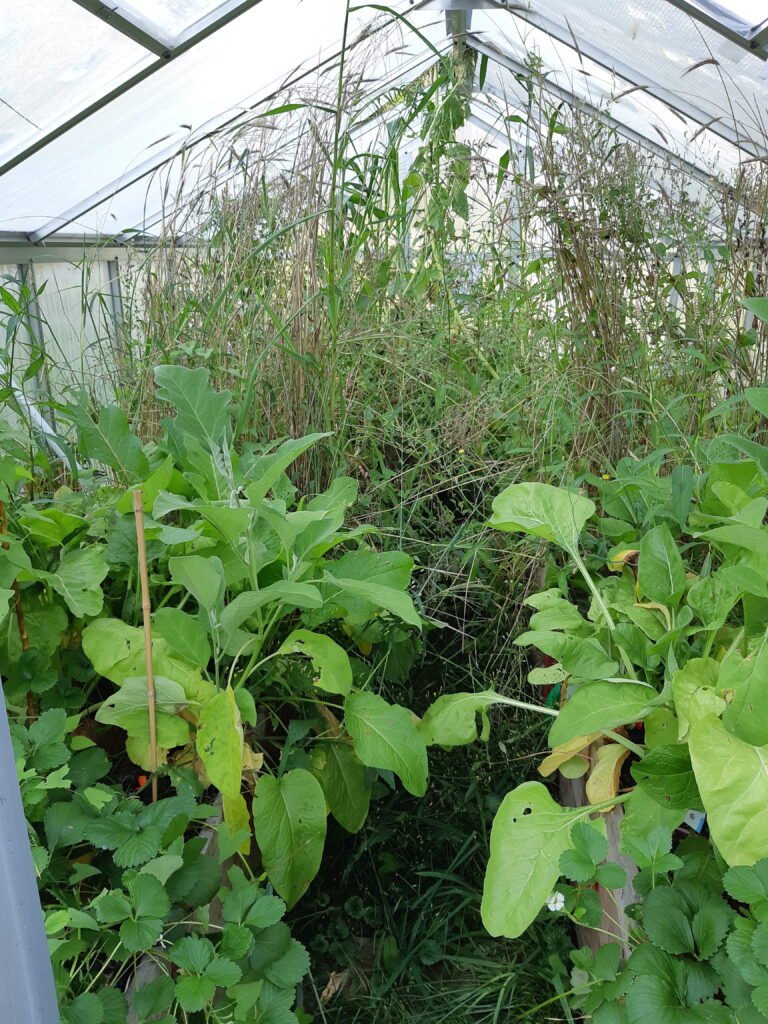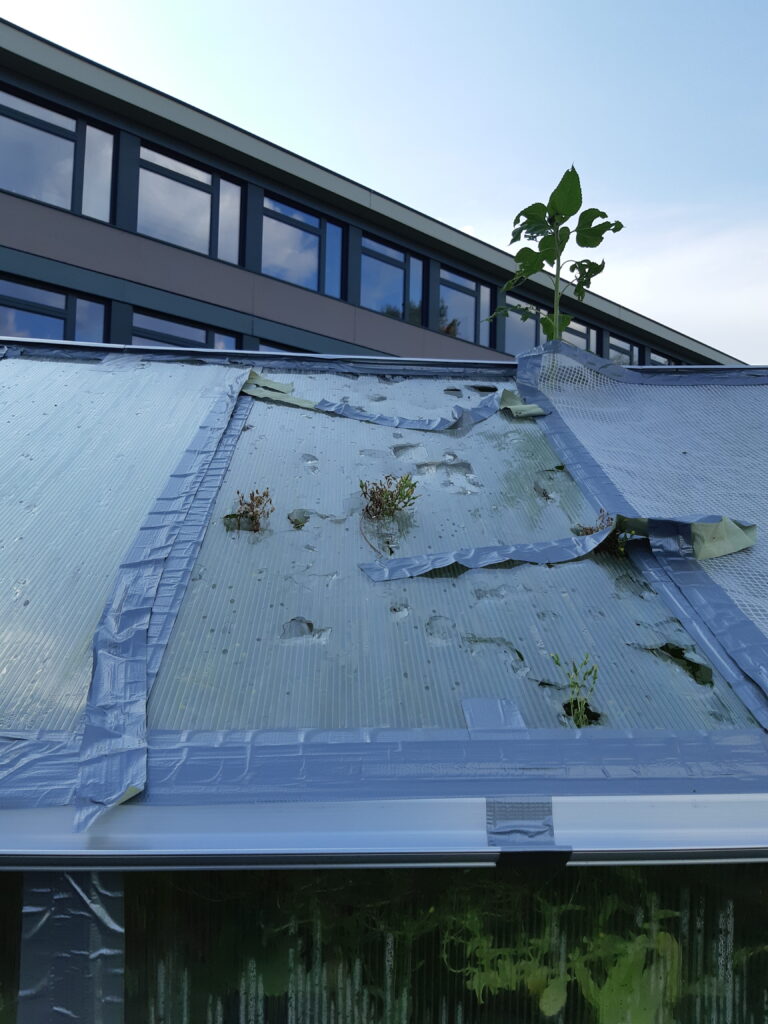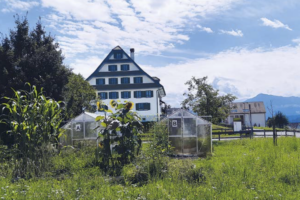Intro
Everything began with a collegial idea. The abstract idea developed into a tangible utopia. There were many aspects of the project challenging the idealistic participants. This didn’t discourage us, instead it encouraged us to meet every obstacle in a creative, collaborative and goal-oriented way. At the beginning, numerous questions were on the table: How exactly? Who with whom? How many? Together or alone? Before, during or after classes? Rather quickly we recognized that the realization of the project depends on numerous administrative factors, our perseverance, and the goodwill of the KSM community.
We would like to grant you some insight into this multifaceted time by retelling some episodes.
The start
A sketch from the beginning encouraged all of us to realize the dream of the climate garden together:

On March 8th, 2021, we made the big step from theory to reality: “We begin today with the construction, these are the instructions for the plant boxes (copies are in the toolboxes as well). […] Next week, we need cordless drills and screwdrivers. Preferably already charged. I’ll bring one – can someone else bring a tool and is available? Would be good if we had 4 devices. Please label and lock in the toolbox in the copy room. Thanks. Can someone take over for me this Friday, March 3rd? I have a meeting and a student volunteered to build plant boxes from 12:45 to 13:15.”
The wooden boxes, which should contain soil and plants in the near future, were constructed by many students as well as teachers. In groups of two or three they stapled with strength, nerves, and endurance. In the end the builders could eternalize their names on the box.
The weather gods interfere
After the material has been delivered, in the middle of March we were surprised by the local weather conditions on the hill of Menzingen, resulting in a delay of the construction of the two greenhouses:
“Dear all:
- If there is snow, we can’t lay out the base on Thursday and Friday. There could be delays. Potentially, we could still build it on Monday 22nd.
- The delivery of the soil is planned for Tuesday March 3rd. If this is not possible due to the weather (rain/snow), this will be delayed too, as well as the construction of the greenhouses. Stay flexible.”
“Dear climate garden builders
With the snow we can’t lay out the bases tomorrow and Friday. During the weekend it should be drier, but probably the ground is completely soaked – currently we can’t build anything stable. We postpone the big construction work for at least one week. Small tasks like screwing footways together/reinforcing boxes are still possible:
- Lay out bases Friday, March 26th/Monday, March 29th
- Protect school building with floor liner Monday, March 29th
- Soil work Tuesday, March 30th
- Construction of greenhouses Wednesday, March 31st”
After figuring out, which paths and tools to use, to fill the plant boxes with soil, the weather gods interfered once more. They were not in our favour:
Damage report of the weekend
“Hello everyone
The greenhouses have been suffering under the wind and snow. Some plastic elements have been dented or dispersed through the area. Additionally, the sink has been thrown over.
Good news: All elements are still intact and be mounted again.
Bad news: One element is currently missing. I hope it will be found somewhere under the snow.
Conclusion: Hopefully there won’t be any more snow, but probably wind. So we have to improve the fixation of the plastic parts. I’ll check tomorrow morning if I can mount the elements again. It could become somewhat painful with the snow if I have to loosen screws. We don’t want to lose any more of them in the snow.
I’m looking forward to the small opening on Thursday. Even if everything might still be looking somewhat battered by then. Maybe we’ll find some time during the SchiLW to restore the greenhouses.”
The opening
Finally! What a strenuous effort. In the middle of April, we could open the climate garden:
“Dear all, thanks to many helping hands the plant boxes are filled, the greenhouses stand firmly attached on their bases. There is still a lot to do: Potentially loosen the screws again, align better, screw better. When fixed, check the panels again, readjust if needed. One door is still missing. Rain gutters are still missing. All components and screws in the greenhouse, tools in the cupboard in the copy room. Thank you all for your major contribution!”
The installation of the watering system was a Sisyphean task, which we won’t describe in detail here. After all it was a means to an end. The installation of the temperature control presented with some difficulties as well:

“Dear climate gardeners, our physics assistant is so nice to take on the heating and cooling control in the greenhouses. Big thank you to him! Unfortunately, the equipment has not arrived yet. Checked with ETH, was referred to the distributor, contacted them. And today starting at 11:15 I’ll piece the greenhouses together again, everyone’s welcome to join. Hope to see all of you on the opening party. Best regards”
The breakthrough
During the following weeks we were struggling with the everchanging weather, causing numerous defects, which had to be (provisionally) repaired.
“Dear all, the greenhouses have been suffering due to the wind. Screws came loose, tape was torn away, wall/roof elements flew away. We will start repairing tomorrow at 10:30. Whoever has time to join is welcome. We’ve seen a wind protection set, maybe we could get that until tomorrow and install immediately. (Rubberized aluminium strips, to mount on the connections.)”
“Climate garden 2085 I’m currently sitting in Zurich on my desk, reading an email that the roof lath of one of the greenhouses is dangerously loose. Is someone at the school and can have a look?”
After the summer holidays we were surprised to see how the plants in the tropical paradise were shooting through the roof, the greenhouses slowly crumbling, the microplastic impairing the soil function and life.


Insights workshops
Accompanying the climate garden, some workshop, conducted by ETH, were offered at KSM. Various topics like climate protection and symbiosis as organic fertilizer were covered:
A focus subject class working for six weeks to prepare various plant species for the workshop was highly excited. Mycorrhizal fungi and their advantage for agriculture was discussed with the students. “One plant was treated with mycorrhizas, the other without. During the workshop we compared how the plants developed.” Unfortunately, the plan of the students yielded disillusioning results. Neither the bean nor the strawberry showed significant differences between the two treatments. But still the students could learn about the scientific way of working. Additionally, most of the student took home not only a small plant for their balcony, but the knowledge about symbiosis.
In an additional workshop by ETH the consequences of the climate change on plants could be investigated close up. “I was not aware, that the climate change has such a direct and measurable effect on my basil plant”, a student reports after the workshop. “I’m aware now that the climate change might be perceptible in my garden as well.” Through the practical engagement with this complex topic, the students learn how everyone carries responsibility for our environment.
Finally, we can say that everyone was happy: The ones thirsty for knowledge and the ones hungry on the meadow.

Translated from German





